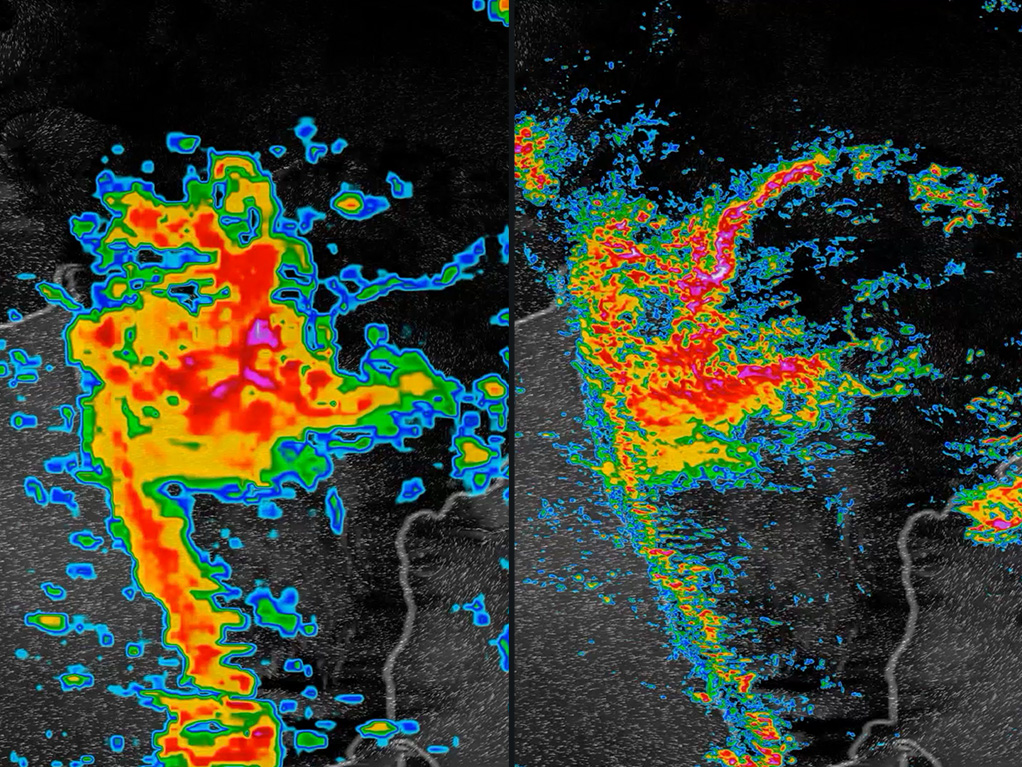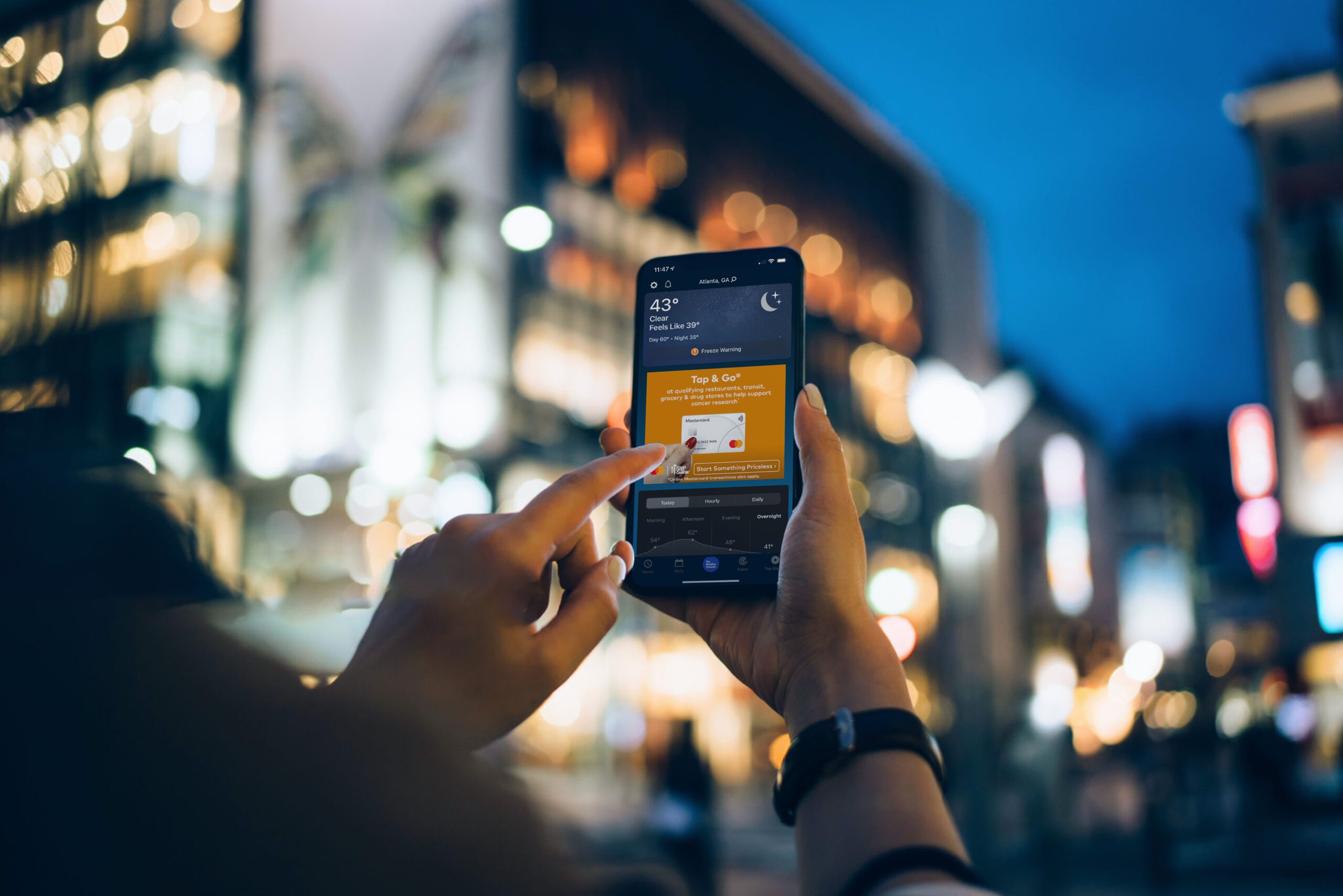AI in weather forecasting, prediction and communication
Continue readingWeather ads use current weather and forecasts of a given area to deliver more relevant advertisements. By using location data, weather-triggered advertising can create contextual and personalized messaging for users that elicits an emotional response and drives them to make purchases.
With weather-based ads, advertisers can control where and when an ad is placed in front of a consumer depending on the forecast. For example, advertisers can choose to only show an ad when the sun is out or when it’s a cloudy day. Alternatively, they can only show an ad when it’s above a certain degree or when there are flurries and a snowstorm is approaching.
The link between weather and advertising
Weather can not only impact one’s daily life and activities, it also is a huge driver of emotions. Many people express that they have more feelings of sadness during the winter months or when it’s raining outside. About 5% of adults in the U.S. experience seasonal affective disorder (SAD). Even more people suffer from a lesser form known as “winter blues.” And while we all know that emotions impact purchase behavior, the weather is often an overlooked factor regarding one’s mood and whether they feel excited about purchasing something.
Weather also influences what products a consumer needs. For example, a coat in the wintertime or a bathing suit and flip-flops in the summer. As an advertiser, you want to be mindful of what area of the world you are placing advertisements in since it doesn’t make sense to advertise a winter coat in California year-round when it’s above 60 degrees most of the year. It also doesn’t make sense to advertise a winter coat in Massachusetts when it is 50 degrees, but it may make sense when consumers experience the same temperature in Miami. By using location data and weather-triggered information, you can start to create more relevant campaigns that turn into conversions.
How effective is weather-based advertising?
Weather is the original influencer. It affects all businesses and people globally and is an unbiased signal that impacts how consumers feel. As a result, leveraging weather insights is an effective way to connect with consumers in a personalized and scalable way.
The importance of weather targeting
Weather is an important but often overlooked component of the sales process. Here are some of the top reasons’ advertisers should start incorporating weather-based advertising into their strategy.
Weather impacts buying patterns
To drive more effective advertising, you’ll want to account for various seasonal triggers that play an active role in buying behavior. For example, in June, beer, suntan lotion and deodorant sales increase. Knowing this, it’s probably a good idea to increase media budgets so that companies can capitalize on this shopping behavior. On the other hand, companies specializing in baking mixes, warm apparel or batteries should consider expanding their advertising efforts starting in November since this is when you can expect sales to increase for these items.
Weather impacts mood
Consumer mindsets change at the start of each new season. Generally, consumers feel a sense of optimism, leading to an increase in spend. In fact, 21%1 of those surveyed noted that the arrival of fall makes them excited to update their wardrobe. For Gen Z, this number is even higher (39%).
Weather can affect whether consumers shop online or in-person
Weather also has a dramatic effect on how users choose to engage with your brand. For example, if it’s a particularly hot day in the summertime, shoppers may be more inclined to go to an air-conditioned mall to make a purchase. If it’s a snowy day in winter though, shoppers may opt for online shopping so they can avoid inclement weather. Knowing this behavior, advertisers can adapt their strategy to align and boost sales whether it’s in person or online.
Minimal changes in temperature can drive big results
It’s important to note that even small changes in weather can have a big impact on sales. Just a small dip in temperature can get people in the mood to start putting on their coats and drinking hot cocoa. Or, in some parts of the country, after a long winter, 60 degrees may feel quite warm and it wouldn’t be surprising if sales of ice cream can go up when springtime comes.
The benefits of using weather forecasting tools for advertising
Weather forecasting tools are a good way for advertisers to dive into weather-based advertising and start achieving their goals. Here are just some of the benefits.
Deliver more relevant messaging
Weather forecasting technology allows your team to access insightful weather data, which can be used to create more relevant ads for your target audience. With weather forecasting data, you can complement previous insights and trends that your team has derived to make better decisions. For example, you can see that in colder weather soup and hot chocolate sales tend to increase.
Knowing this, you can target specific groups before a snowstorm or during a particularly cold week to increase engagement. Personalized content is becoming more important than ever to consumers. Brands that want to stay competitive utilize weather ads to deliver more personalized content to end-users. By applying AI and dynamic creative optimization, you can also use weather insights to deliver the right message at scale across your advertising ecosystem, based on the weather forecast.
Increase marketing ROI
Weather-triggered advertising can also be good for your company’s ROI. By better targeting customers based on what’s relevant to them, you can anticipate an increase in leads, conversions, and eventually, the retention of customers. One study found that companies with a clearly defined marketing-led personalization function were 38% more likely to earn 400% ROI or more than their counterparts.
Personalize your campaigns
Individualized ads are becoming increasingly important. Fifty-two percent of customers expect offers to always be personalized. Unfortunately, companies are falling short of these rising expectations. Sixty-six percent of customers expect companies to understand their unique needs and expectations, but only thirty-four percent of companies generally treat customers as individuals.2 Neglecting to create personalized experiences can cause you to lose customers in the short term and tarnish your brand reputation in the long run.
The steps to incorporate weather ads into your strategy
Are you ready to begin implementing weather-triggered advertising into your strategy? Here are the steps to get started.
Leverage AI to make data-driven decisions
It’s easy to make assumptions when creating a strategy around the weather. However, conclusions should be based on data so that you can make the most informed decisions possible.
For example, an ice-cream seller may assume that as temperatures increase, sales will also increase. However, higher temperatures may also mean ice cream could melt in the car. So instead, people may opt to stay indoors in the air conditioning and eat a popsicle from their freezer.
Additionally, 67%1 of those surveyed said fall made them crave richer and more comforting foods, especially when it is stormy. 69% agree that fall impacts their grocery purchases. For food manufacturers and grocery stores, these insights can help determine which products to promote and when, based on the weather forecast. Because there are so many factors that influence advertising decisions, concentrate on concrete data and machine learning.
AI advertising can help by providing more insights. In any campaign, it’s important to not make assumptions about how a product performs in a specific climate. By using large amounts of data and artificial intelligence, you can spot trends to help determine how to create more impactful campaigns tailored to the weather conditions around them.
Consider your demographic
It’s also important to consider the demographic you’re targeting with weather-based ads. This is because the same weather can feel different to various groups of people based on the city in which they live. For example, while 50 degrees in Miami can feel chilly to locals and lead to an increase in sales for coats, 50 degrees in April in Boston would indicate springtime weather.
Use high-quality weather forecasting data
The insights you derive from your AI advertising solution can only be as accurate as the information on which it is based. And unfortunately, bad data quality is a problem for most organizations. According to a 2020 survey, less than half of respondents (46%) had a formal data governance strategy in place. For organizations that prioritize AI, clean data is fundamental.
This is why it is so important to use high-quality forecasting data. Solutions use forecasting data from the airport level. But The Weather Company can leverage high-quality information from various sources, such as cell-phone sensors, for higher resolution data that can derive more detailed insights.
Examples of weather-triggered advertising
There are several examples of companies across industries that have used weather-triggered advertising to aid their strategy and boost their revenue.
Industries who can benefit from weather-based advertising
Retail and sales
Retail has been a very volatile industry over the past year. In fact, 46% of US consumers surveyed by Periscope by McKinsey have made a switch of brands or retailers over the past few months. Therefore, having a strong advertising strategy is more important than ever. With e-commerce spending increasing exponentially throughout the pandemic, rising 30% from the beginning of March 2020 to mid-April 2020, retailers should consider how to strengthen their strategy by further personalizing their messaging.3 Tactics such as weather-based advertising can fit well into this equation.
Retailers also need to consider how the weather will impact what products will be bought. This can help them decide which products to show in-store near the register for impulse buys (for example, mittens in the winter or umbrellas on a rainy day) and which products would be better to advertise.
Apparel manufacturers
Apparel manufacturers should also consider implementing weather ads into their advertising strategy. People need different kinds of clothes based on their region and the weather they are experiencing. For example, on a particularly cold week, you can advertise coats. For a warmer week in the winter, you may pause campaigns related to snow pants or gloves.
Grocery stores
People also change their grocery list and buying behavior based on what the weather will be like. Before a bad storm, people will often buy in bulk and stock up on essential items like bread, eggs and pasta. Additionally, when the weather is warm, people may be more likely to purchase watermelon or other summertime treats.
Insurance
Insurance companies also need to be mindful of the weather and how it impacts the need for insurance. One way to do so is if data is showing there will be an influx of severe weather. Knowing this, insurance companies can time their advertisements with upcoming storms to remind people of the benefits of insuring their homes and properties.
Automotive
Automotive advertising campaigns can also leverage weather-triggered advertising to deliver powerful results. Automotive companies can leverage weather insights to determine which types of cars to promote and when consumers are most likely to buy. Weather data can also be used to encourage consumers to test drive a car or to highlight EV charging stations. Subaru is committed to safety and approached The Weather Company to reinforce this mission during severe weather conditions. They created the Driving Difficulty Index (DDI) Commuter Forecast Too, which leveraged accurate weather data and maps from The Weather Channel. Subaru was able to reach drivers as they got up-to-date information on upcoming storms, resulting in impressive engagement on The Weather Channel.
Weather-based advertising case studies
Weather can be used in a wide variety of ways to connect with consumers. Below are two case studies.
Subaru showed its dedication to consumer safety with accurate weather data
Subaru is committed to safety and approached The Weather Company to reinforce this mission during severe weather conditions. They created the Driving Difficulty Index (DDI) Commuter Forecast Too, which leveraged accurate weather data and maps from The Weather Channel. Subaru was able to reach drivers as they got up-to-date information on upcoming storms, resulting in impressive engagement on The Weather Channel.
Two ice cream brands leverage weather data to drive sales
Two leading ice cream brands wanted to drive more sales during the summer season. The Weather Company was able to leverage the brands’ sales data and a custom weather analysis to determine which conditions impacted product sales the most.
Leveraging these insights, the ice cream brands saw:
- 26% increase in sales
- $1.23 overall ROI
- 35% waste reduction
- Adjusted delivery in real time (accounting for extreme weather events)
Challenges in weather-based advertising
As a result of climate change and the tools available, there are a number of challenges advertisers will face when trying to implement weather ads.
Seasonal norms may change
The fall 2022 season is looking to have warmer temperatures, which could prolong spending associated with summer. As climate change continues to impact the weather, it’s important for advertisers to be agile. Brands who fail to adapt their strategy based on the current forecast will miss out on opportunities to connect with their audiences.
Leveraging location data
Not all weather targeting solutions leverage machine learning and location data into their algorithms. It’s important for brands to understand how different weather conditions feel to audiences across the world.
Why use Weather Targeting?
Weather Targeting uses AI algorithms to collect the most accurate weather data available to help you create highly targeted advertising campaigns that don’t rely on third-party cookies. By better anticipating the needs and buying habits of your customers, you can improve your ad effectiveness, create more personalized experiences, and drive leads and conversions that boost your business.
Ready to learn more about weather-triggered advertising? Check out Weather Targeting, an AI solution or contact us today.
Frequently asked questions
Weather impacts how consumers feel, giving it a strong influence over the decisions people make. As a byproduct, weather impacts how users convert and the messages they will respond to.
Yes, weather-specific advertising delivers a more personalized and relevant experience to your target demographic. Weather is the original influencer, since it impacts how consumers feel and businesses operate.
Let’s talk
What’s your weather strategy? To learn more about increasing campaign efficiencies and personalizing messages at the most relevant moments, contact our advertising experts today.
Contact us1 Fall Seasonal Outlook, by The Weather Company Advertising, 2021.
2 State of the Connected Customer, Salesforce, 4th Edition—2020.
3 Retail reimagined: The new era for customer experience, Periscope by McKinsey, Aug 2020.







